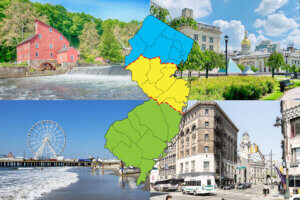It has been six months since Superstorm Sandy left an indelible mark on New Jersey. While two-thirds of those in the hardest hit areas are now back to normal, about 1-in-7 are far from recovery. The Monmouth University/Asbury Park Press Poll also finds a dip in confidence over how federal aid is being spent. Also, many New Jerseyans are reluctant to provide taxpayer aid to private homeowners who choose to live in high-risk coastal areas.
More than 3-in-4 New Jersey families (78%) report they either have fully recovered or were not impacted by Superstorm Sandy. In the hardest hit areas of the state, 67% of residents say they are now fully recovered, which is up from 57% in February and 53% in December. However, the number of families in the hardest hit communities who have only barely recovered or not recovered at all has not gone down. This number currently stands at 15%, compared to 14% in February and 12% in December.
Nearly 3-in-4 New Jerseyans say they are very (31%) or somewhat (42%) satisfied with the state’s recovery effort so far. Only 20% are dissatisfied. In the hardest hit areas of the state, satisfaction with the pace of recovery has gone down slightly, from 75% in February to 69% currently, although this change is within the margin of sampling error for this group. In other parts of the state, satisfaction has actually increased slightly to 74%, up 4 points from 71% in February.
Garden State residents remain generally confident that federal relief funds will be spent wisely on the recovery effort, although this confidence has dropped among residents of the hardest hit communities. Statewide, 60% say they are confident, which is down slightly from 64% who said the same in February. In the hardest hit areas, the drop in confidence is even larger, now standing at 52% confident down from 64% two months ago.
“Sandy recovery seems to be moving along for most New Jerseyans, but some of the hardest hit residents are making little to no progress and becoming more pessimistic,” said Patrick Murray, director of the Monmouth University Polling Institute. “It’s unclear what state aid will be made available to those homeowners if the public’s reticence to assist affected residents in high-risk areas is taken into account.”
Prior Monmouth University/Asbury Park Press Polls found widespread public support for using New Jersey tax dollars to support recovery efforts that would improve storm resilience, restore beach amenities, rebuild businesses, and help inland urban residents affected by the storm. In December 2012, more than 2-in-3 Garden State residents supported each of these proposals, but support for helping shore homeowners was significantly lower. The current poll finds that 52% of New Jerseyans support using state tax dollars to help rebuild severely damaged private homes down the shore, while 44% are opposed to this use of public funds. This finding represents nominal majority support, but is significantly lower than support levels for other potential recipients of storm-related aid found in our December 2012 poll.
Residents who oppose state aid for affected shore homeowners were asked to state in their own words why they feel that way and these responses were grouped into categories. Issues of personal responsibility top the list of reasons why some New Jerseyans oppose this type of assistance. About 1-in-4 of those opposed (27%) say it is simply not appropriate for state government to use taxpayer money to help any private homeowner. Another 15% say that shore homeowners should not get state aid because they knew the risks of buying a house near the ocean. Others give insurance related reasons, saying either that shore homeowners’ current insurance policies should cover the costs (18%) or that these homeowners should have purchased more insurance coverage (12%).
Other reasons given by those opposed to public aid for shore homeowners have to do with prudent use of limited public funds. This includes 14% who say that New Jersey tax dollars are needed for other programs or programs that serve the entire state, 4% who say that the money would be wasted, 4% who say it would lead to a future tax increases, and 6% who say that shore homes shouldn’t be rebuilt because they will just get hit again. Another 3% say public aid should come from FEMA or the federal government and 2% say it should come from local taxes or beach fees.
Other reasons given by those opposed to helping shore homeowners with state funds include the perceived wealth of shore homeowners who can afford to pay their own rebuilding costs (9%) and the perception that the damaged properties are mainly second homes or vacation homes (8%). These issues were specifically probed in follow-up questions on the poll.
All New Jersey residents polled were asked about the perceived affluence of affected shore homeowners. Two-thirds say these homeowners are mostly middle or working class (66%) compared to 24% who feel they are mostly well-off financially. Among those who support aiding shore homeowners, only 16% think most of them are financially comfortable. Among those who are opposed, though, the number believing that most affected shore homeowners are affluent is slightly higher at 34%.
Statewide opinion is split when it comes to whether most damaged shore properties are permanent homes or vacation properties – 38% of Garden State residents think they are mostly year-round homes and 36% think they are mostly vacation homes. Among those who support helping affected shore homeowners, 44% feel most of them are year-round residents and 33% say they are vacation homeowners. This perception is flipped among those opposed to state aid – 42% say these affected properties are mainly vacation homes and 30% say most are year-round homes.
New Jersey opinion is also divided on whether the risks of coastal living should be factored into allocating Sandy aid. Just under half (48%) of Garden State residents agree that shore homeowners should not receive as much help as inland homeowners after a disaster because of the known risks of owning a house near the ocean. A similar 46%, though, disagree with this assessment. Interestingly, residents of the hardest hit areas of the state are also split on whether shore homeowners should get less help because they knowingly took the risk – 44% agree to 49% disagree. However, a clear majority (58%) of those who oppose publicly funded assistance for damaged shore homes say that these homeowners deserve less help than others because of the known risks of living near the ocean.
The Monmouth University/Asbury Park Press Poll was conducted by telephone with 806 New Jersey adults from April 11 to 14, 2013. This sample has a margin of error of ± 3.5 percent. The poll was conducted by the Monmouth University Polling Institute and originally published by the Asbury Park Press and its sister publications (Courier-Post, Courier News, Daily Journal, Daily Record, and Home News Tribune).
Methodological Note:
For this survey, the classification of “Hardest Hit Area” includes zip codes covering coastal communities – on both beach and bay – in the four Jersey Shore counties as well as flooded urban communities in the northern part of the state (e.g. Moonachie, Little Ferry, Hoboken, parts of Jersey City, Perth Amboy, etc.). These areas represent 14% of the survey sample.
The “Region” classification for this Sandy-specific survey is defined by county: Northeast (Bergen, Passaic, Essex), Route 1 (Hudson, Union, Middlesex, Mercer), Northwest (Somerset, Hunterdon, Morris, Warren, Sussex), Shore Counties (Monmouth, Ocean, Atlantic, Cape May), and Southwest (Burlington, Camden, Gloucester, Salem, Cumberland).
DATA TABLES
The questions referred to in this release are as follows:
(* Some columns may not add to 100% due to rounding.)
1. Would you say your family has fully recovered from the storm, partially recovered, barely recovered, or not recovered at all?
|
TOTAL | INCOME | NJ REGION |
HARDEST | ||||||||
|
<$50K | $50- $100K | $100K+ | North- east | Route 1 | North- west | Shore counties | South- west | Yes |
Other | ||
| Fully recovered | 78% | 73% | 78% | 88% | 79% | 74% | 84% | 76% | 83% | 67% | 80% |
| Partially recovered | 15% | 18% | 14% | 9% | 14% | 18% | 12% | 15% | 11% | 18% | 14% |
| Barely recovered | 5% | 6% | 6% | 1% | 5% | 7% | 3% | 5% | 3% | 10% | 4% |
| Not at all recovered | 2% | 3% | 2% | 2% | 1% | 2% | 1% | 4% | 2% | 5% | 2% |
| (VOL) Don’t know | 0% | 0% | 0% | 0% | 1% | 0% | 0% | 0% | 1% | 0% | 0% |
| TREND: | April 2013 | Feb. 2013 | Dec. 2012 |
| Fully recovered | 78% | 77% | 74% |
| Partially recovered | 15% | 14% | 18% |
| Barely recovered | 5% | 4% | 4% |
| Not at all recovered | 2% | 5% | 3% |
| (VOL) Don’t know | 0% | 0% | 0% |
| Unwtd N |
806 | 803 |
816 |
2. Are you satisfied or dissatisfied with the state’s Sandy recovery effort so far? [Is that very or somewhat (satisfied/dissatisfied)?]
|
TOTAL | INCOME | NJ REGION |
HARDEST | ||||||||
|
<$50K | $50- $100K | $100K+ | North- east | Route 1 | North- west | Shore counties | South- west | Yes |
Other | ||
| Very satisfied | 31% | 25% | 31% | 39% | 35% | 31% | 32% | 23% | 33% | 31% | 31% |
| Somewhat satisfied | 42% | 48% | 41% | 42% | 43% | 42% | 45% | 43% | 38% | 38% | 43% |
| Somewhat dissatisfied | 11% | 12% | 11% | 10% | 11% | 11% | 9% | 16% | 10% | 14% | 11% |
| Very dissatisfied | 9% | 9% | 12% | 5% | 7% | 10% | 7% | 13% | 10% | 11% | 9% |
| (VOL) Don’t know | 6% | 6% | 5% | 5% | 5% | 5% | 7% | 5% | 9% | 6% | 6% |
| TREND: | April 2013 | Feb. 2013 |
| Very satisfied | 31% | 26% |
| Somewhat satisfied | 42% | 45% |
| Somewhat dissatisfied | 11% | 12% |
| Very dissatisfied | 9% | 10% |
| (VOL) Don’t know | 6% | 7% |
| Unwtd N |
806 |
803 |
3. How confident are you that federal relief funding for New Jersey’s Sandy recovery effort will be spent wisely – very, somewhat, not too, or not at all confident?
|
TOTAL | INCOME | NJ REGION |
HARDEST | ||||||||
|
<$50K | $50- $100K | $100K+ | North- east | Route 1 | North- west | Shore counties | South- west | Yes |
Other | ||
| Very confident | 12% | 15% | 8% | 13% | 9% | 14% | 16% | 12% | 8% | 13% | 12% |
| Somewhat confident | 48% | 47% | 51% | 50% | 56% | 40% | 54% | 46% | 47% | 39% | 50% |
| Not too confident | 19% | 20% | 20% | 18% | 22% | 18% | 13% | 21% | 24% | 21% | 19% |
| Not at all confident | 17% | 15% | 20% | 17% | 12% | 25% | 15% | 16% | 17% | 23% | 17% |
| (VOL) Don’t Know | 3% | 3% | 1% | 2% | 1% | 3% | 3% | 5% | 3% | 4% | 2% |
| TREND: | April 2013 | Feb. 2013 |
| Very confident | 12% | 13% |
| Somewhat confident | 48% | 51% |
| Not too confident | 19% | 17% |
| Not at all confident | 17% | 15% |
| (VOL) Don’t Know | 3% | 4% |
| Unwtd N |
806 |
803 |
4. Do you support or oppose using state tax dollars to help rebuild severely damaged private homes down the shore? [Is that strongly or somewhat (support/oppose)?]
|
TOTAL | INCOME | NJ REGION |
HARDEST HIT AREA | ||||||||
|
<$50K | $50 – $100K | $100K+ | North-east | Route 1 | North-west | Shore counties | South-west | Yes |
Other | ||
| Strongly support | 27% | 36% | 24% | 23% | 28% | 32% | 27% | 24% | 20% | 28% | 27% |
| Somewhat support | 25% | 28% | 22% | 19% | 26% | 27% | 20% | 27% | 20% | 21% | 25% |
| Somewhat oppose | 17% | 11% | 23% | 20% | 20% | 13% | 14% | 17% | 21% | 15% | 17% |
| Strongly oppose | 27% | 21% | 28% | 36% | 24% | 23% | 35% | 27% | 33% | 33% | 26% |
| (VOL) Don’t know | 4% | 5% | 2% | 2% | 2% | 4% | 4% | 5% | 5% | 3% | 4% |
[The following question was asked only of those who said “OPPOSE” in Q4, moe= ± 5.0%]
5. What is the main reason you oppose this? [LIST WAS NOT READ] [Note: Results add to more than 100% because multiple responses were accepted]
|
TOTAL | INCOME | NJ REGION |
HARDEST HIT AREA | ||||||||
|
<$50K | $50- $100K | $100K+ | North- east | Route 1 | North- west | Shore counties | South- west | Yes |
Other | ||
| Personal responsibility, not govt./taxpayers’ | 27% | 24% | 24% | 33% | 30% | 27% | 21% | 32% | 24% | 23% | 28% |
| They were aware of risks | 15% | 12% | 16% | 15% | 10% | 16% | 12% | 17% | 17% | 23% | 13% |
| Should have had (more) insurance | 12% | 13% | 9% | 12% | 14% | 9% | 12% | 10% | 11% | 12% | 11% |
| Their insurance should cover it | 18% | 16% | 21% | 17% | 11% | 18% | 26% | 17% | 23% | 13% | 19% |
| FEMA/Federal Govt. should cover it | 3% | 1% | 4% | 2% | 2% | 2% | 1% | 3% | 5% | 3% | 3% |
| Local taxes/beach fees should cover it | 2% | 1% | 2% | 2% | 1% | 3% | 5% | 0% | 1% | 0% | 2% |
| These are second/vacation homes | 8% | 5% | 6% | 13% | 6% | 6% | 11% | 2% | 12% | 0% | 10% |
| Wealthy owners, can afford it | 9% | 13% | 9% | 6% | 6% | 10% | 10% | 12% | 8% | 18% | 8% |
| Shouldn’t build at all there, will get hit again | 6% | 7% | 5% | 7% | 4% | 6% | 6% | 5% | 10% | 3% | 7% |
| Spend tax money on whole state, other programs | 14% | 18% | 7% | 13% | 17% | 13% | 15% | 10% | 10% | 15% | 13% |
| Would not be spent wisely, waste | 4% | 4% | 7% | 2% | 6% | 9% | 2% | 0% | 2% | 8% | 3% |
| Our taxes would go up | 4% | 1% | 8% | 4% | 7% | 2% | 2% | 2% | 6% | 0% | 5% |
| Other | 3% | 6% | 2% | 2% | 2% | 8% | 1% | 3% | 2% | 1% | 4% |
| No answer | 3% | 8% | 2% | 1% | 3% | 4% | 1% | 9% | 0% | 11% | 2% |
6. Based on what you know or have heard, were the shore houses damaged by Sandy mostly homes of people who live there year-round or were they mostly vacation homes?
|
TOTAL | INCOME | NJ REGION | HARDEST HIT AREA |
HELP SHORE | |||||||||
|
<$50K | $50- $100K | $100K+ | North- east | Route 1 | North- west | Shore counties | South- west | Yes | Other | Support |
Oppose | ||
| Mostly year round homes | 38% | 42% | 39% | 33% | 38% | 43% | 35% | 40% | 34% | 44% | 37% | 44% | 30% |
| Mostly vacation homes | 36% | 34% | 38% | 38% | 33% | 36% | 43% | 28% | 42% | 30% | 38% | 33% | 42% |
| (VOL) Equal number | 16% | 14% | 14% | 21% | 18% | 15% | 14% | 22% | 12% | 20% | 16% | 14% | 18% |
| (VOL) Don’t know | 10% | 10% | 9% | 8% | 11% | 6% | 8% | 11% | 12% | 7% | 10% | 8% | 10% |
7. Do you think most of the shore homeowners affected by Sandy are financially comfortable or are most of them middle or working class?
|
TOTAL | INCOME | NJ REGION | HARDEST HIT AREA |
HELP SHORE | |||||||||
|
<$50K | $50- $100K | $100K+ | North- east | Route 1 | North- west | Shore counties | South- west | Yes | Other | Support |
Oppose | ||
| Most are financially comfortable | 24% | 26% | 20% | 26% | 20% | 25% | 22% | 23% | 28% | 20% | 24% | 16% | 34% |
| Most are middle or working class | 66% | 65% | 71% | 63% | 70% | 67% | 65% | 64% | 64% | 70% | 65% | 77% | 54% |
| (VOL) Equal number | 5% | 3% | 5% | 7% | 6% | 4% | 7% | 8% | 3% | 3% | 6% | 4% | 7% |
| (VOL) Don’t know | 5% | 6% | 4% | 4% | 4% | 4% | 5% | 6% | 5% | 7% | 4% | 3% | 5% |
8. Do you agree or disagree that shore homeowners shouldn’t receive as much help as inland homeowners after a storm disaster because they knowingly accepted the risks when they bought a house near the ocean?
|
TOTAL | INCOME | NJ REGION | HARDEST HIT AREA |
HELP SHORE | |||||||||
|
<$50K | $50- $100K | $100K+ | North- east | Route 1 | North- west | Shore counties | South- west | Yes | Other | Support |
Oppose | ||
| Agree | 48% | 48% | 53% | 45% | 44% | 52% | 48% | 43% | 50% | 44% | 48% | 40% | 58% |
| Disagree | 46% | 44% | 44% | 50% | 50% | 43% | 43% | 49% | 46% | 49% | 46% | 56% | 34% |
| (VOL) Depends | 3% | 3% | 2% | 5% | 4% | 2% | 5% | 4% | 1% | 5% | 3% | 2% | 4% |
| (VOL) Don’t know | 4% | 4% | 2% | 1% | 3% | 2% | 5% | 4% | 4% | 2% | 3% | 2% | 3% |
The Monmouth University/Asbury Park Press Poll was conducted by the Monmouth University Polling Institute from April 11 to 14, 2013 with a statewide random sample of 806 adult residents, including 606 contacted on a landline telephone and 200 on a cell phone. Live interviewing services were provided by Braun Research, Inc. and the telephone sample was obtained from Survey Sampling International. Monmouth is responsible for all aspects of the survey questionnaire design, data weighting and analysis. For results based on the total sample, one can say with 95% confidence that the error attributable to sampling has a maximum margin of plus or minus 3.5 percentage points. Sampling error increases as the sample size decreases, so statements based on various population subgroups, such as separate figures reported by gender or party identification, are subject to more error than are statements based on the total sample. In addition to sampling error, one should bear in mind that question wording and practical difficulties in conducting surveys can introduce error or bias into the findings of opinion polls.
It is the Monmouth University Polling Institute’s policy to conduct surveys of all adult New Jersey residents, including voters and non-voters, on issues that affect the state. Specific voter surveys are conducted when appropriate during election cycles.
|
POLL DEMOGRAPHICS (weighted) | |||
| 39% Dem | 48% Male | 28% 18-34 |
64% White |
| 39% Ind | 52% Female | 38% 35-54 |
12% Black |
| 22% Rep | 34% 55+ |
15% Hispanic | |
|
9% Asian/Other | |||
Click on pdf file link below for full methodology and results by key demographic groups.




